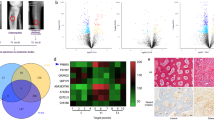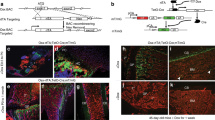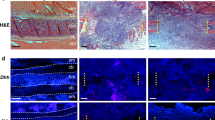Abstract
Adenovirus vectors are expected to be a powerful tool for gene therapy to treat severe fractures. Adenovirus invades cells through binding to the coxsackievirus and adenovirus receptor (CAR) on the cell membrane. CAR expression is low in normal adult animals, but it is induced on regenerating cells in some experimental models. We made a rib fracture model in mice and evaluated the histological changes and CAR mRNA expression by RT-PCR 1, 5, 10, 14, and 21 days after the fracture. CAR mRNA was expressed exclusively in the fractured ribs at each time point, but not in the normal ribs. We detected the CAR protein immunohistochemically in fibroblast-like cells in the fracture callus on days 10 and 14 after fracture. In situ hybridization showed that these fibroblast-like cells expressed mRNA of type I collagen and osteopontin, but not osteocalcin, defining the cells as immature osteoblasts. We then transferred small doses (104–108 PFU) of lacZ-expressing adenovirus vector into immature osteoblasts on day 14. β-galactosidase was detected only on the immature osteoblasts at every dose. Immature osteoblasts play an important role in the matrix replacement step in fracture healing. CAR-mediated gene transfer into immature osteoblasts can be reasonable for adenovirus-mediated treatment of fracture healing.
This is a preview of subscription content, access via your institution
Access options
Subscribe to this journal
Receive 12 print issues and online access
$259.00 per year
only $21.58 per issue
Buy this article
- Purchase on Springer Link
- Instant access to full article PDF
Prices may be subject to local taxes which are calculated during checkout








Similar content being viewed by others
References
Bouxsein ML et al. Recombinant human bone morphogenetic protein-2 accelerates healing in a rabbit ulnar osteotomy model. J Bone Joint Surg Am 2001; 8: 1219–1230.
Radomsky ML et al. Novel formulation of fibroblast growth factor-2 in a hyaluronan gel accelerates fracture healing in nonhuman primates. J Orthop Res 1999; 17: 607–614.
Kawaguchi H et al. Acceleration of fracture healing in nonhuman primates by fibroblast growth factor-2. JCE & M 2001; 86: 875–880.
Fechner H et al. Expression of coxsackie adenovirus receptor and alphav-integrin dose not correlate with adenovector targeting in vivo indicating anatomical vector barriers. Gene Therapy 1999; 6: 1520–1535.
Ito M et al. Expression of coxsackievirus and adenovirus receptor in hearts of rats with experimental autoimmune myocarditis. Circ Res 2000; 86: 275–280.
Conget PA, Minguell JJ . Adenoviral-mediated gene transfer into ex vivo expanded human bone marrow mesenchymal progenitor cells. Exp Hematol 2000; 28: 382–390.
Joseph A, Thomas AE, Marsh JL . Bone and Joint Healing. Rockwood and Green's Fractures in Adults. Lipponcott Williams & Wilkins: Philadelphia, 2001, pp 247–251.
Nakase T et al. Alterations in the expression of osteonectin, osteopontin and osteocalcin mRNAs during the development of skeletal tissues in vivo. Bone Miner 1994; 26: 109–122.
Stein GS et al. Mechanisms Regulating Osteoblast Proliferation and Differentiation. Principles of Bone Biology. Academic Press: San Diego, 1996, pp 69–86.
Mehrara BJ et al. Adenovirus-mediated gene therapy of osteoblasts in vitro and in vivo. J Bone Miner Res 1999; 8: 1290–1301.
Uusitalo H et al. Accelerated up-regulation of L-sox 5, Sox 6, and Sox 9 by BMP-2 gene transfer during murine fracture healing. J Bone Miner Res 2001; 10: 1837–1845.
Baltzer WA et al. Potential role of direct adenoviral gene transfer in enhancing fracture repair. Clin Orthop 2000; 379S: 120–125.
Yamagiwa H et al. Expression of metalloproteinase-13 (collagenase-3) is induced during fracture healing in mice. Bone 1999; 25: 197–203.
Nakase T et al. Transient and localized expression of bone morphogenetic protein 4 messenger RNA during fracture healing. J Bone Miner Res 1994; 9: 651–659.
Chomczynski P et al. Single-step method of RNA isolation by acid guanidinium thiocyanate–phenol–chloroform extraction. Anal Biochem 1987; 162: 156–159.
Abe TK et al. The presence of the 50-kDa subunit of dynactin complex in the nerve growth cone. Biochem Biophys Res Commun 1997; 233: 295–299.
Hirota S et al. Expression of osteopontin messenger RNA by macrophages in atherosclerotic plaques. A possible association with calcification. Am J Pathol 1993; 143: 1003–1008.
Author information
Authors and Affiliations
Rights and permissions
About this article
Cite this article
Ito, T., Tokunaga, K., Maruyama, H. et al. Coxsackievirus and adenovirus receptor (CAR)-positive immature osteoblasts as targets of adenovirus-mediated gene transfer for fracture healing. Gene Ther 10, 1623–1628 (2003). https://doi.org/10.1038/sj.gt.3302060
Received:
Accepted:
Published:
Issue Date:
DOI: https://doi.org/10.1038/sj.gt.3302060
Keywords
This article is cited by
-
Systemic administration of mesenchymal stem cells combined with parathyroid hormone therapy synergistically regenerates multiple rib fractures
Stem Cell Research & Therapy (2017)
-
Treatment of osteoarthritis using a helper-dependent adenoviral vector retargeted to chondrocytes
Molecular Therapy - Methods & Clinical Development (2016)
-
Expression of coxsackievirus and adenovirus receptor in human lung cancer: Possible clinical significance
Clinical Oncology and Cancer Research (2010)
-
Orthopedic Gene Therapy in 2008
Molecular Therapy (2009)
-
Delayed administration of adenoviral BMP-2 vector improves the formation of bone in osseous defects
Gene Therapy (2007)



